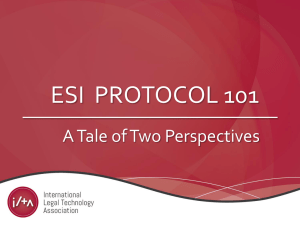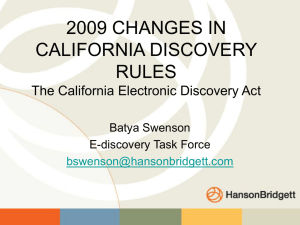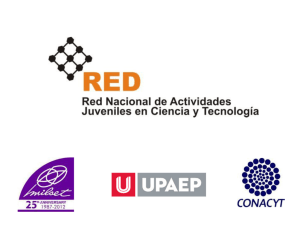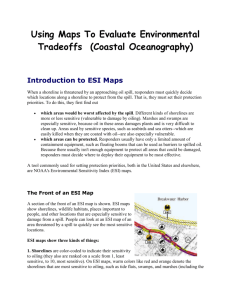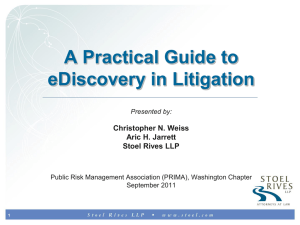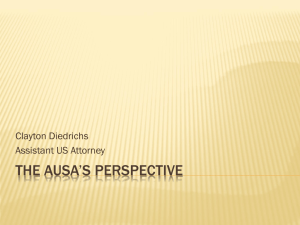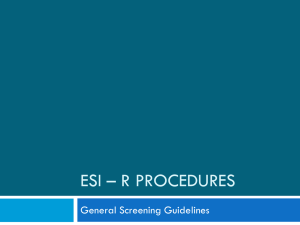ediscovery_prof_resp_Hedges
advertisement
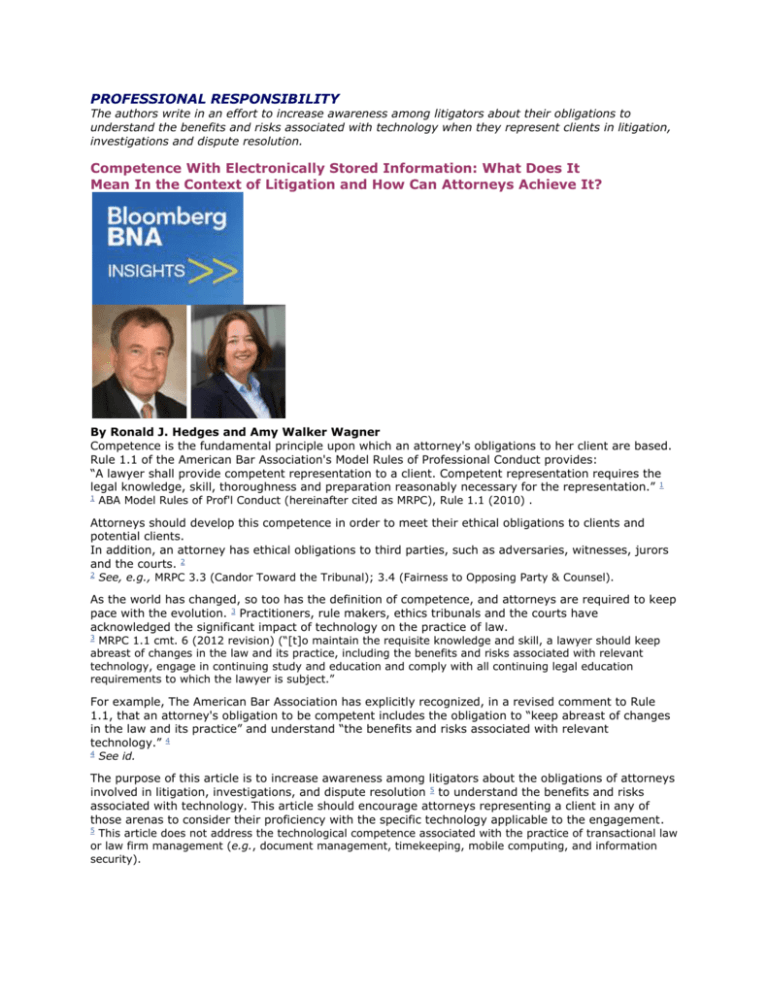
PROFESSIONAL RESPONSIBILITY The authors write in an effort to increase awareness among litigators about their obligations to understand the benefits and risks associated with technology when they represent clients in litigation, investigations and dispute resolution. Competence With Electronically Stored Information: What Does It Mean In the Context of Litigation and How Can Attorneys Achieve It? By Ronald J. Hedges and Amy Walker Wagner Competence is the fundamental principle upon which an attorney's obligations to her client are based. Rule 1.1 of the American Bar Association's Model Rules of Professional Conduct provides: “A lawyer shall provide competent representation to a client. Competent representation requires the legal knowledge, skill, thoroughness and preparation reasonably necessary for the representation.” 1 1 ABA Model Rules of Prof'l Conduct (hereinafter cited as MRPC), Rule 1.1 (2010) . Attorneys should develop this competence in order to meet their ethical obligations to clients and potential clients. In addition, an attorney has ethical obligations to third parties, such as adversaries, witnesses, jurors and the courts. 2 2 See, e.g., MRPC 3.3 (Candor Toward the Tribunal); 3.4 (Fairness to Opposing Party & Counsel). As the world has changed, so too has the definition of competence, and attorneys are required to keep pace with the evolution. 3 Practitioners, rule makers, ethics tribunals and the courts have acknowledged the significant impact of technology on the practice of law. MRPC 1.1 cmt. 6 (2012 revision) (“[t]o maintain the requisite knowledge and skill, a lawyer should keep abreast of changes in the law and its practice, including the benefits and risks associated with relevant technology, engage in continuing study and education and comply with all continuing legal education requirements to which the lawyer is subject.” 3 For example, The American Bar Association has explicitly recognized, in a revised comment to Rule 1.1, that an attorney's obligation to be competent includes the obligation to “keep abreast of changes in the law and its practice” and understand “the benefits and risks associated with relevant technology.” 4 4 See id. The purpose of this article is to increase awareness among litigators about the obligations of attorneys involved in litigation, investigations, and dispute resolution 5 to understand the benefits and risks associated with technology. This article should encourage attorneys representing a client in any of those arenas to consider their proficiency with the specific technology applicable to the engagement. This article does not address the technological competence associated with the practice of transactional law or law firm management (e.g., document management, timekeeping, mobile computing, and information security). 5 If an attorney is not competent to provide the counsel required in light of the technology involved, she should seek competent assistance, refer the matter to another attorney or decline the representation. An attorney should not blindly use technology in which she has no level of competence. Competence Fundamentals In order to be competent when investigating and using relevant technology and electronic data, an attorney must recognize that this endeavor implicates issues of law, technology, privacy and security. Decisions about technology can materially impact the cost, course and context of litigation (including the ability to ensure that data is not inappropriately altered, to present evidence to support the claims and defenses at issue in the matter, to meet court or other deadlines for the production of data, and to comply with legal and ethical obligations to protect the data at issue). These considerations require an attorney to evaluate, recommend or implement appropriate decisions regarding technology and electronic data. Attorneys should understand basic technological terminology and know where to search for additional information and continuing education. 6 See, e.g., The Sedona Conference® Glossary: E-Discovery & Digital Information Management (Fourth Edition April 2014). 6 All Discovery is ‘eDiscovery.' The obligation to ensure competence in evaluating, recommending and implementing appropriate decisions regarding technology and electronic data is overarching in a practice focused upon litigation, dispute resolution, investigations and regulatory inquiries. Virtually all evidence that supports an alleged claim, regulatory violation or defense will be electronic in nature and will require an understanding of technology. It is no longer credible for an attorney to contend that her practice does not involve the collection, review, production or receipt of electronically stored information (ESI). The Matter Defines the Competence Required While all attorneys should be competent to discuss, manage and determine strategy related to the discovery of ESI, the ESI at issue in a particular matter will dictate the level of sophistication required in order to be competent. For example, attorneys involved in a single-plaintiff employment discrimination case that involves only ESI stored on a single computer, with no web-based, network, structured, or backup data of any kind, will demand a less detailed understanding of the discovery of ESI than a complex securities fraud matter with sophisticated entities on both sides. The Need to Understand Technological Issues to Negotiate Scope of Discovery Civil discovery is a cooperative, iterative process. An attorney's obligation to be competent includes the obligation to cooperatively conduct discovery in civil litigation. Such cooperation includes the disclosure of sources of potentially relevant ESI. To be competent, an attorney should be aware of the rules and law that provide the framework for reasonable and proportional discovery. An attorney should understand and be able to describe the sources and characteristics of potentially relevant ESI, both in her client's possession, custody or control, as well as data in the possession, custody or control of her adversary and third parties. Furthermore, an attorney should be capable of understanding the burden—financial, temporal and otherwise—associated with the preservation, collection, review and production of particular sources of ESI, both for her client's own data and that of her adversaries and third parties. To be competent, an attorney should be able to engage in a cooperative discussion about the scope of discovery in a particular lawsuit, including: • The law applicable to the discovery of ESI, including the applicable rules of civil procedure and evidence, as well as common law; • Any requirements with respect to the discovery of ESI set forth by the tribunal in which the attorney is representing the client (e.g., a model electronic discovery order endorsed by the district court in which the case is pending, a standing order related to the production of ESI entered by the judge before whom the case is pending, rules applicable to the alternative dispute resolution forum in which the case is pending); • Any other guidance with respect to the discovery of ESI that is significant in the tribunal in which the attorney is representing the client (e.g., electronic discovery principles or guidelines adopted by the court in which the case is pending); • As discussed in more detail below, how to identify and explain the potentially relevant ESI in the possession, custody and control of her client, including ESI in the possession of third parties that may be deemed to be under her client's control; • As discussed in more detail below, how to request and identify potentially relevant ESI in the possession, custody, and control of the opposing party, including data in the possession of third parties that may be deemed to be under the opposing party's control; • How to craft, explain, negotiate and direct the strategy for the culling of the ESI to be discovered in the case, including specifically: § Whether a targeted search will be conducted; § Whether technology assisted review will be used, including: §Whether key word searching will be used, including: • To what fields such key words will be applied, • What particular key word syntax is used by the tool to conduct the searches, and • Whether there are any limitations to the tool used to conduct the searches (i.e., it lacks the capability to search attachments to e-mails). • How to craft, explain, negotiate and direct the format of production of the ESI to be discovered in the case, including specifically: § Whether any file formats of ESI are to be excluded from discovery; § The file format in which to produce ESI, including whether to produce in native or static format, or some combination of the two; § The potential need for redacting documents, and ensuring the efficacy of those redactions; § The handling of native file and production metadata for her client's and the opposing party's ESI, including: • The metadata fields available in her client's ESI; • The metadata fields to be produced to the opposing party; and • The metadata fields that may be available in the opposing party's ESI and those to be produced to her client. Competence and Technological Issues Associated With Identification of Relevant ESI A critical step of the process is identifying potentially relevant ESI. An attorney should know what constitutes ESI and electronic locations where potentially relevant ESI can be found. An attorney should be capable of investigating the potentially relevant sources of ESI in the possession, custody and control of her client. In addition, an attorney should be able to assess the potentially relevant sources of ESI in the possession, custody and control of the opposing party. An attorney should understand the right questions to pose, both to her client and the opposing party, as well as the information provided in response to those inquiries. As discussed in more detail below, an attorney also should be able to assess and comprehend the significance of the retention of potentially relevant ESI. To be competent, an attorney should be able to identify potentially relevant ESI, including understanding: • The types of potentially relevant ESI in her client's possession, custody and control, including specifically: § Is there a document retention or destruction policy and how is it implemented? § What is the e-mail system in use currently and historically? § What are the implications, if any, on the availability of potentially relevant e-mail? § What non-e-mail sources of communication does the client allow (e.g., instant messaging application, text messages, etc.)? § What are the potential repositories of “loose files” (i.e., files not attached to an e-mail)? § What databases or structured data does the client maintain or access that may contain potentially relevant ESI (e.g., accounting, human resources, sales or customer relationship manager applications)? § What web-based sources of potentially relevant ESI exist? § What potentially relevant ESI, if any, is contained on users' computers or mobile devices? § What potentially relevant ESI, if any, is contained on a network or shared drive? § Are there any legacy systems, databases or repositories that may contain potentially relevant ESI? § What kind of data back-ups are created, at what intervals, for how long are they retained, and what information is contained? § What kind of newly developed technologies (e.g., wearable technology, telemetry) may be at issue in the case? § What kind of data may be in the possession of third parties that may be under her client's control? • How to request and identify the types of potentially relevant ESI in the opposing party's possession, custody and control; and • How to identify the employees and other users currently or formerly associated with the client that may have created, accessed or saved potentially relevant ESI. Competence and Technological Issues Associated With Preservation of Relevant ESI Common law has long recognized the obligation of a party or potential party to preserve evidence that may be relevant to a dispute. The digitization of life in the 21st century through ever-evolving technology including e-mails, instant messaging, personal computing, file sharing servers, databases, web-based content, mobile applications and hundreds of other categories of ESI emphasizes the need for early action to ensure preservation of potentially relevant data. Depending on the type of ESI and the repository in which the ESI is stored, it may be inadvertently and permanently lost. An attorney responsible for the discovery of ESI should understand the technological characteristics and preservation implications of the potentially relevant ESI at issue in the case. The sometimes protracted nature of litigation may exacerbate these concerns, as litigation often addresses events that occurred many years in the past, and discovery of that evidence does not occur until yet more time has passed. To be competent, an attorney should be able to recommend sound preservation strategies for potentially relevant ESI, including understanding: • The implications of the length of time for which data is retained by her client or the opposing party, such as: § Whether an internet or cellular service provider automatically deletes logs of text messages after a particular amount of time; § Whether a web-based storage site automatically deletes files after a particular amount of time; § Whether a call center retains tapes or digital recordings of calls for a particular amount of time. • Any automatic overwriting of data applicable to potentially relevant sources of ESI, such as: § Whether a corporation overwrites media containing backups of active data on a particular schedule; § Whether an individual overwrites data saved to her computer when she upgrades her operating system to a new version. • The procedures in place for data and devices used by an employee or other user who has left a corporate client, including: § The disposition of a former user's e-mail account; § The disposition of a former user's computer; § The disposition of a former user's smart phone; § The disposition of a former user's personal network drive; § The disposition of a former user's files saved to a shared drive. • How to communicate the need to preserve potentially relevant ESI to those individuals with the ability to ensure that preservation, including: § Whether to communicate a request that an individual with potentially relevant data preserve that ESI (a “Litigation Hold”); § Whether anyone other than the individuals who have created or accessed the potentially relevant ESI must receive notice of the Litigation Hold, such as: • The corporation's Information Technology staff who must turn off any automatic e-mail deletion procedures applicable to a user's account; • Human Resources staff who receive notice of an employee's termination and set in motion a series of events that deletes the now former employee's ESI; • The corporation's Marketing staff who has the ability to access and modify content on the corporation's eCommerce site; and • The spouse or other associates of a client who access, use and have the ability to delete files contained on the computer that contains the potentially relevant ESI. • Ensuring that recipients of a Litigation Hold are complying with the hold by periodically reminding them of the need to preserve evidence; • The ability of the method of preservation to ensure the security of the potentially relevant ESI at issue, such as: § Ensuring there are no automatic deletions applicable to an e-mail account that houses e-mails you have instructed be preserved; § Understanding whether other users can unintentionally modify files saved to a shared drive that are to be preserved. • When and how a client can cease the preservation of potentially relevant ESI. Competence and the Technological Issues Associated With Collection of Relevant ESI ESI resides on many platforms. For example, a single user may have e-mail data: • In her active e-mail mailbox housed on her employer's exchange server, • In archive files she created on her laptop; • In an application on her smartphone; • Saved to a thumb drive; • Saved to a firewall repository that makes a copy of any incoming e-mail containing particular suspicious phrases or attachments; • In a journaling system implemented by her employer; and • Saved to a backup tape. To be competent, an attorney should be able to assess locations are the best sources for the relevant ESI sought. In addition, the way in which potentially relevant ESI is collected may impact the utility of that data. For example, if a loose file is opened or copied during the collection process, certain of the metadata fields (like time and date-stamps and last user) associated with the file may be altered, which may have implications on the facts that can be demonstrated by the use of the file. The facts of each engagement, the types of potentially relevant ESI, and the facts to be proven by the use of evidence will dictate what method of collection should be used. To be competent, an attorney should be able to thoughtfully recommend collection strategies for potentially relevant ESI, including an understanding of: • The ways ESI may be collected, taking into account whether the collection method will alter evidence in any manner and whether that alteration will be material; • The implications of the collection method on the issues in dispute in the matter, including: § An assessment of what data may be altered as a result of the collection method and ensuring the method of collection will not prevent the parties from discovering material facts, such as: • Whether the information available in various metadata fields (such as the date on which a file was created, the author of a file, and the file path of a document) may be relevant. • Whether a targeted collection (i.e., where potentially relevant ESI is collected from only particular locations) would be appropriate under the circumstances; • Whether a custodian-directed collection (i.e., where the individuals with knowledge search their own files for potentially relevant ESI) would be appropriate under the circumstances; • Whether a forensic collection (i.e., a complete bit-by-bit image of the machine that may include deleted content still available on the computer) would be appropriate under the circumstances; • Whether a particular searching technology has the capability to search data in the way in which a party has represented, such as whether a searching tool can search the content of e-mails and attachments, or whether a file searching tool can search the filename and the content of the file; • Whether the syntax used to conduct a key word search is appropriately drafted for the tool the attorney is using to conduct the search. • Whether the sources from which you are collecting are complete yet tailored to the potentially relevant ESI at issue, including: § Whether there is a need to collect data from a computer if all potentially relevant ESI is stored on a network server; § Whether there is a need to collect data from individual users' e-mail accounts when a corporation maintains a journaling system from which all e-mails can be collected. Competence and the Technological Issues Associated With Hiring Service Providers Many lawyers and clients partner with service providers to assist with the discovery of ESI. An attorney is responsible for the conduct of a service provider or non-lawyer working under her supervision. 7 Accordingly, an attorney should ensure that a service provider she retains to assist with the discovery of ESI is competent to undertake the tasks assigned, and to ensure compliance with the attorneys' other ethical obligations, such as protection of confidential client data 8 and adversaries' data. 9 The tools used by service providers vary significantly in their functionality, sophistication, and cost. 7 See MRPC 5.3. 8 See MRPC 1.6. 9 See MRPC 3.4. To be competent in the retention of service providers, an attorney should be capable of undertaking a reasonable investigation of the tools and services that will be provided by the service provider, testing the service provider's skills and maintaining sufficient supervision over the service providers' work, including an understanding of: • The service provider's experience in providing the service and tools sought; • The service provider's capacity to provide the service and tools sought; • The pricing structure imposed by the service provider; • The geographic location where the service provider will process and host the client or opposing party data collected, if any, and related implications, such as: § Whether the service provider will be transferring data to a different jurisdiction that could cause the client to violate an agreement or the law, or impact the client's ability to obtain the data at a later time; • The security applied by the service provider to the data; • The period of time for which the service provider will retain the data; • The service provider's ability to use the data for any other purpose. Competence and Technological Issues Associated With Review And Production of Relevant ESI Technology has allowed attorneys to become increasingly sophisticated in their review of potentially relevant data. Among the various technological methods available to attorneys for narrowing the potentially relevant data are de-duplication, near duplication and e-mail threading. Attorneys can also rely on certain types of technology assisted review to identify potentially responsive documents. Attorneys can use keyword searches and leverage metadata fields to assist in identifying particularly sensitive or potentially privileged communications. To be competent in reviewing and producing potentially relevant ESI, an attorney should understand: • The value of entering into formal agreements or orders regarding the preservation, identification and production of ESI; • The value of entering into a claw-back or quick peek agreement; • The methods of ensuring that privileged communications and attorney work product, including information embedded in metadata, are not inadvertently produced; 10 • The law applicable to the production of protected data; • The capabilities of the review tool used; • The ways in which to use the technology to achieve the goals sought; • The methods for using keyword searching and an understanding of its limitations; • The methods for filtering metadata by custodian, date range, sender, receiver and file type; • How to use de-duplication, near duplication and e-mail threading to reduce the overall size of the dataset; • Whether there are any restrictions or limitations on the data to be searched and produced (e.g., encryption, password protection, legacy data); and • The precedential case law regarding the use of advanced search techniques beyond key word searches (e.g., predictive coding, machine learning, concept clustering, other advanced culling and analytics tools). 10 See MRPC 4.4(b). Competence and Technological Experience Of Co-Counsel, Consultants, Experts and Scope of Their Work Many attorneys participate in litigation with the assistance of co-counsel. In addition, attorneys retain consultants and experts to assist with litigation. It is critical for attorneys to remember that, at the end of the day, they are accountable for the litigation and the resulting consequences that could arise as a result of delegating work to others, such as co-counsel, experts and consultants. Similarly, it is critical for the attorney to understand the technological sophistication of their cocounsel and consultants/experts before any work is delegated or shared. To be competent in working with co-counsel and consultants/experts, an attorney should: • Understand the responsibility of co-counsel and consultants/experts; • Understand the technological experience of co-counsel and consultants/experts; • Confirm that client data is being stored and transmitted securely; • Confirm that confidentiality protections are being maintained; • Ensure that confidentiality agreements and protective orders are implemented and followed; • Keep well-informed of the discovery process and supervise decisions; and • Understand, at least generally, any technology that is the focus of an expert's opinion or advice. Competence and Technological Issues Associated With Investigating and Communicating With Witnesses, Unrepresented Parties, Jurors and Courts Attorneys should learn and follow the jurisdiction's limitations and requirements concerning the use of electronic resources (e.g., text messages, search engines, commercial services like Lexis and Westlaw, social media, online directories, websites, etc.) in investigating and communicating with witnesses, unrepresented parties and prospective or empaneled jurors. Attorneys should also understand the court's requirements for electronic filing and measures to take to protect confidential or privileged information. To be competent in using technology to investigate or communicate with witnesses, unrepresented parties and prospective or empaneled jurors, an attorney should understand: • The restrictions on the use of electronic resources for the investigation of witnesses and jurors; • The reliability, credibility and accuracy of the electronic resources used for the investigation; • The applicable jurisdiction's rules and ethics opinions governing the use of internet resources and communications through social media; • The technological implications of the electronic resources used to investigate and communicate with witnesses; • The applicable jurisdiction's ethics principles governing honesty and candor in communications with witnesses and jurors, such as the prohibition against the use of deception; and • The obligation to ethically and appropriately employ technological resources to diligently and competently investigate publicly available information, which will advance her client's case. Similarly, attorneys should know the applicable jurisdiction's court rules, the judge's preferences and/or standing orders and any precedential ethics opinions that address limitations on communications with the court. Just as with traditional means of communications, communications through an electronic medium (e.g., e-mail, text messages, social media, and/or other means of electronic communication) can also raise ethical issues about the propriety of the communication and whether it is an inappropriateex parte communication. While some jurisdictions might not prevent a judge from being “friends” on social media with an attorney that appears before her, a competent attorney will be careful to avoid creating an appearance of impropriety or suggest that the attorney has special access to the judge through their status as “friends” on social media. A competent attorney who is a “friend” of a judge on social media will also avoid posting any commentary on matters pending before the judge. Filing documents with the court is another method of communication with the court. Competent attorneys should be educated about their court's electronic filing requirements and procedures for filing documents. RESOURCES LINK TEXT HERE Ronald J. Hedges is a special master, arbitrator, and mediator working with eDiscovery and privilege issues. He served as a United States Magistrate Judge in the District of New Jersey from 1986 to 2007. Amy Walker Wagner is a partner at Stone & Magnanini LLP, Berekley Heights, New Jersey. She focuses her practice on False Claims Act, complex commercial, and intellectual property litigation. This article is for general information purposes and is not intended to be and should not be taken as legal advice. The opinions expressed are those of the author(s) and do not necessarily reflect the views of their firms or clients.
